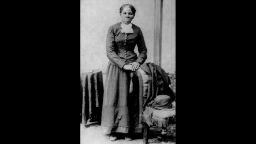Editor’s Note: Donna Brazile, a CNN contributor and a Democratic strategist, is vice chairwoman for voter registration and participation at the Democratic National Committee. A nationally syndicated columnist, she is an adjunct professor at Georgetown University and author of “Cooking With Grease: Stirring the Pots in America.” The opinions expressed in this commentary are hers.
Story highlights
Harriet Tubman will be the face of the new $20 bill
Donna Brazile explains why it's appropriate to honor a woman who was instrumental in the causes of fighting slavery and getting women the right to vote.
On Wednesday, Treasury Secretary Jacob J. Lew announced several important and historic changes in the design of U.S. currency. Among them is a plan to replace Andrew Jackson on the $20 bill with the famed abolitionist and former slave Harriet Tubman.
The original plan launched last summer was to replace Alexander Hamilton on the $10 bill, with Tubman being one of the leading candidates. But further consideration—and perhaps the mammoth popularity of the Broadway rap musical “Hamilton”—has resulted in the decision to put Tubman on the $20.
Alexander Hamilton is safe, Harriet Tubman gets the coveted automated bank teller $20 gig, and the often maligned Andrew Jackson is out in the cold.
Here is my reaction, written last year, to the original plan. It outlines Tubman’s historic career and foreshadows the new decision to put her on the $20:
Tubman a popular choice
The U.S. Treasury has announced plans to put a woman on the $10 bill. Why not? We put a man on the moon. This should be easier, if somewhat more contentious. The redesign of the $10 bill is taking place in 2020 to help mark the 100th anniversary of the 19th Amendment, which gave women the right to vote. The Treasury Department is inviting the public to weigh in on which woman it should be.
The early favorite is also my own personal favorite – famed abolitionist and hero of the Underground Railroad, Harriet Tubman. Tubman has been heavily touted as a replacement for Andrew Jackson on the $20 bill. People campaigning to put a woman on the $20 bill held an online poll this year that drew more than 600,000 responses. Tubman got the most votes – more than 100,000 – narrowly to beat out former first lady Eleanor Roosevelt.

Harriet Tubman wouldn’t be the first woman to appear on U.S. money, but she would be the first African-American – woman or man – to be so honored. Women who have already been depicted on coins include Susan B. Anthony, on the $1 coin from 1979 to 1981, and Sacajawea, the Native American woman who guided the Lewis and Clark expedition, and who has been on the $1 gold coin since 2000.
The goddess Liberty was on dozens of different coin designs of every denomination in the early years of American coinage. I don’t know if goddesses have ethnicity – the goddess Liberty on the coins looks white, but I like to think that she identifies with all ethnicities and races, including African-Americans.
Why she’s famous
There are many reasons that Tubman is a front-runner in the race to replace Alexander Hamilton on the $10 bill. She is justly famous for the many people she helped to escape from slavery.
Born a slave herself around 1820, she escaped and fled to the North in 1849. But she risked her newfound freedom returning to the South 19 times in the subsequent years. In all, she personally led more than 300 slaves to freedom along the Underground Railway.

During the Civil War, Tubman helped the Union cause by serving as a cook and a nurse for Union troops in Confederate territory. She conducted scouting expeditions for the Union Army, worked as a spy and even helped conduct the planning and execution of Union raids on plantations along South Carolina’s Combahee River.
In her later years, Tubman worked for women’s right to vote alongside well-known suffragettes such as Anthony. Her social and humanitarian work took so much of her time and energy that she lived much of her life in poverty.
Tubman lived until 1913, at the age of around 91 (her date of birth is uncertain). After growing to adulthood as a slave, she helped to end that cruel institution and died only seven years shy of seeing women win the right to vote.
Harriet Tubman’s lifetime covered some of the most monumental social progress in American history, and she was instrumental in making much of it happen. I can’t think of a person more deserving to be honored by appearing on our nation’s currency.


